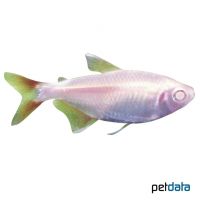Buenos Aires Tetra Albino (Psalidodon anisitsi 'Albino')
| Buenos Aires Tetra Albino Psalidodon anisitsi 'Albino' | |
|---|---|
| Name | Buenos Aires Tetra Albino |
| Name Lat. | Psalidodon anisitsi 'Albino' |
| Synonym | Hyphessobrycon anisitsi |
| Family | Characins |
| Family lat. | Characidae |
| Order | Characins |
| Order lat. | Characiformes |
| Origin | Paraguay, Brazil |
| Habitat | Streams, ponds |
| Diet | Omnivore |
| pH | 5.5-8.0 |
| Behavior | Peaceful |
| Keeping | Group |
| Care Level | Easy |
| Reproduction | Egg scatterer |
| Breeding | Simple |
| Life Span | 5-6 years |
| Protection | No |
| Metric Units | |
| Size | 7-8 cm |
| Temperature | 18-28 °C |
| Hardness | 5-20 °dH |
| Aquarium | ~ 150 l |
| US Units | |
| Size | 2.8"-3" |
| Temperature | 64-82 °F |
| Hardness | 89-356 ppm |
| Aquarium | ~ 40 gal |
Distribution and habitat
The rhombic spotted tetra is common in the La Plata region, which stretches from southeastern Brazil through Paraguay to Argentina. They live in slow flowing and stagnant waters, such as small rivers, streams, lakes, ponds and ponds.
Maintenance
The aquarium should have a varied, partly dense planting, with shelters and hiding places (roots) and provide sufficient swimming space. A dark substrate covered with some foliage (e.g. sea almond leaves), shaded light (floating plants) and a weak current is ideal.
No ammonia, ammonium and nitrite should be detectable, the nitrate value should not exceed 100 mg/l. To ensure the water quality and oxygen content, a filter and heater adapted to the aquarium size is required, as well as lighting for the species-appropriate day-night rhythm of the animals.
Diet
The food supply consists of live, frozen and dry food. For a balanced diet, feed once a day with a high-quality dry food (flakes, granules, pellets) as well as cyclops, daphnia, artemia, mosquito larvae, etc. (live or frozen). In addition, they need vegetable food, such as algae leaves, scalded spinach or commercially available green food
It is recommended to feed small portions several times a day, which are eaten within a few minutes. A regular and varied diet promotes health and increases resistance.
Behaviour and compatibility
These lively fish live in groups and can be well maintained in a community tank with other tetras as well as with non-predatory fish and catfish. Care should be taken when socializing with dwarf shrimp. They should be kept in a group of at least 5-10 fish.
In principle, only mutually compatible fish species with similar requirements to the water condition and water temperature may be socialized.
Sex dimorphism
Males have more vibrant red or yellowish fins and are slightly smaller than females, which appear rounder and fuller.
Reproduction and breeding
They are free spawners, spawning several hundred eggs between fine-feathered plants. After 24-36 hours the larvae hatch and swim freely after about 4 days. The parents do not perform brood care and should be separated from the fry after spawning, as they are spawn predators.
Juveniles must be fed several times a day with special rearing food (dust food). Breeding is hardly possible in community tanks, as the spawn is easy prey.
Important
They are considered fin twitchers. Kept in a large enough aquarium and in a group, other fish are not bothered and their occasionally quarrelsome behavior remains intraspecific. Feeding with plant food reduces the risk of the fish eating the tender shoots of aquatic plants.
Foliage (sea almond, oak, etc.) enriches the water with humic substances, naturally lowers the pH, and is a valuable secondary food source.
The well-being of the fish should be monitored regularly. Temperature should be checked daily, pH, hardness and nitrate levels should be checked at least every 14 days. Regular partial water changes are recommended, even when contaminant levels have not yet reached the upper limit. Sudden changes in water quality should be avoided. Newly introduced fish must be accustomed slowly to the water in the aquarium.
Further literature can be found in your pet store.
References
Text: Sabina Lamboj; Image: petdata
Source: BMELV (1998): Tierschutzgutachten - Haltung von Zierfischen (Süßwasser); RIEHL & BAENSCH (2006): Aquarien Atlas Bd. 1, Mergus Verlag; ENGELMANN (2005): Zootierhaltung - Tiere in menschlicher Obhut: Fische, Verlag Harri Deutsch
- Gemäß § 21 Abs. 5 Tierschutzgesetz idgF
